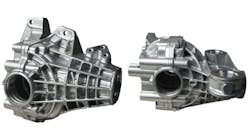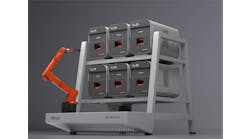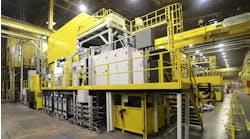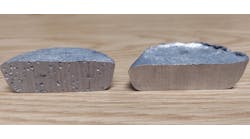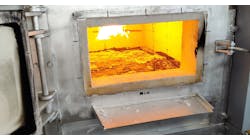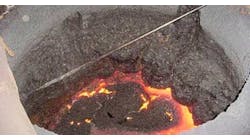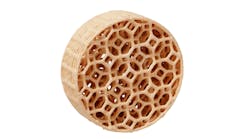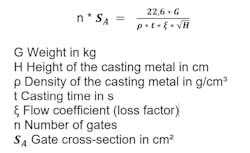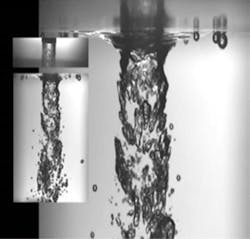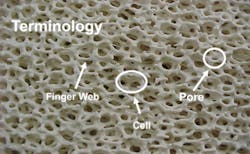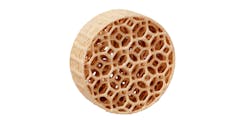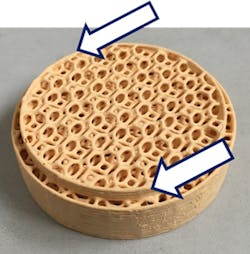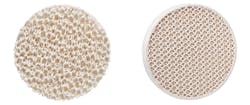Ceramic-foam filters made of high-purity oxide ceramics are the state-of-the-art for filtration in the metalcasting industry. The main advantage of using these filter elements is to increase foundry efficiency by reducing rework through the reduction of non-metallic inclusions in the melt.
But note that there are limits to the structure of sintered ceramic-foam filters: The production of ceramic-foam filters can result in structures that favor the formation of filter bits, and these bits may compromise the purity of the melt. By using innovative 3D-printed filters, metalcasters can prevent these impurities.
Filtration of liquid metals
The pursuit of molten metal purity has always been a part of casting operations. For ferrous and nonferrous metals and their alloys – non-metallic impurities in the melts are fundamentally undesirable. Their presence almost always leads to impairment of the properties of the cast part, including casting scrap that leads to economic losses. It may be possible to rework cast parts, but even this should be seen as a last resort. It means additional expense, and in some cases repair is not feasible because certain subsequent applications of the parts will not allow it.
Avoiding contamination during the casting process is therefore crucial. This requires the operators to address two main points: removing existing impurities in the melt using suitable subsidies, and reducing reoxidation during casting by filling the mold cavity as smoothly and with as little turbulence as possible. Avoiding turbulence in particular plays a central role in the production of clean castings. This detail should already be considered during the conception and design of the casting and gating system. Applying the available casting simulation programs is extremely helpful here.
But why is a smooth filling process so important? To understand this, it is worth taking a brief look at physics, or more precisely the fluid mechanics of liquids, and considering the interactions between flow velocity and the geometry of the areas through which the flow passes.
The Reynolds number
Briefly, the Reynolds number Rn is the ratio of the inertial forces acting on the flow particles (in this case of a fluid) to the viscous forces (frictional forces) of the same. It is dimensionless and, among other things, it is used to differentiate between laminar flow and turbulent flow. Laminar flow is specified with a Reynolds number of < 2000, and turbulent flow with a Reynolds number of > 4000. The area in between these two states is referred to as laminar unstable.
What does this have to do with casting? A lot. To determine a metalcasting system, foundries use an equation derived from the basic formulas of fluid mechanics to calculate the gate of the castings:
In this equation a casting-related coefficient ξ is used, which is intended to account for flow-related velocity losses. In addition to the usual flow deflections in the casting system, this includes the Reynolds number. The casting method (e.g., falling, rising, etc.), the cross-section ratios (sprue/runner/sum of all gates), and the effective pouring heights are taken into account. Other data is also included.
Even a simple inlet can lead to metal contamination. In a very interesting paper about air entrainment during mold filling, S.H. Majidi and C. Beckermann showed that this is one of the main sources of oxygen, which leads to the formation of reoxidation inclusions and thus impurities. At an impact velocity of approximately 5 m/s of the poured stream of material into a standing liquid bath, a ratio of 1:1 liquid volume to entrained air was determined.
This makes it clear that the reduction of turbulence plays an extremely important role when it comes to avoiding non-metallic inclusions in melts. Many measures are taken during melting, but also outside and inside the mold cavity. Regardless of whether slag retention or special sprues are involved, one aid is particularly suitable here: The ceramic-foam filter.
Filter in ceramic foam
Using refractory ceramic foam filters for filtration, and more important for calm mold filling, is highly appreciated. Foam ceramic filters are available in different materials, which must fulfill some basic common requirements: good chemical, thermal and mechanical properties are just some of them.
Materials used include silicon carbide, zirconium oxide, aluminum oxide with possible stabilizers and binders. Partially stabilized zirconium oxide is very often used for the highest demands. Depending on the manufacturing process used for the base material, it is available in two colors (white and tan/orange.) The disadvantage of manufacturing such filters from this material is the shrinkage that takes place during the firing process of the filters, which can amount to up to 20% and makes compliance with the corresponding dimensional tolerances of the respective filters quite challenging. If you take a close look at the normal filter structure, you will notice repeating structures. Figure 4 identifies specific formations known as web fingers, cells, and pores.
Although the distribution of pores and cells has a certain regularity, it nevertheless varies in its exact arrangement, size, and connections, so that foams have a distribution within the same “pores per inch” (PPI) number. Filters are classified in PPI, which enables the capacities and possible flow rates to be estimated depending on the metal flowing through the filter.
Identifying filters by PPI classes and other classifications is usually done visually, by specially trained personnel using comparative standards (retainers.) This is an entirely manual procedure and is the subject of controversial debate, but it has been a common and sufficiently accurate system for many years.
Other techniques may be used, tailored to particular applications, such as agreed weight checks or similar. Special methods, such as an impingement test, can also be used to obtain more precise data and apply it in a targeted manner.
Despite all the efforts of filter manufacturers, the quality of the ceramic-foam filters depends on the quality of the phenolic urethane foams. Despite all precise and strict controls, structures may be present in the foams that negatively influence filtration efficiency and the behavior during the flow of liquid metal through the filter. The possible presence of thin, interrupted webs, non-uniform structures and pore sizes can have a negative influence.
The smallest particles, so-called filter bits, which may not be sintered firmly enough to the base material, could be detached during pouring of molten metal.
Latest innovation
The solution for effectively preventing filter bits and at the same time ensuring the repeatability of the filter structures is to manufacture filters using suitable 3D printing processes. The advantage of this process is obvious: exact reproducibility. Once the structure of the filter is available as a CAD file, clean geometries are available and can always be reproduced exactly as designed. The 3D-printed filter (Fig. 5) represents a new quality of reproducibility. Each printed filter is identical to the previously printed one, and the next filter will be exactly the same. This significantly improves process reliability.
At a glance, these are the advantages of EXACTPORE:
- Consistent flow properties with every filter
- Significant reduction of potentially dislodging particles
- Improved flow behavior of the melt
- Increased filter capacities
- Precise and consistent pore sizes, even according to individual requirements
- Freely scalable pore sizes
- Customized solutions with the greatest possible design freedom
- More precise simulation options
EXACTPORE 3D filters avoid filter bits and make possible a significant increase in flow capacity compared to standard filters. The free design options and scaling possibilities allow entirely new approaches in the production of filters. Previously, the cast part and casting technology were adapted to the filter: now, the filter can be adapted to the special requirements of the casting.
Possibilities and product variations
The new possibilities are just one feature of the use of printed filters. Another feature is the avoidance of filter tipping. During the pouring of the melt into a sprue hopper, the normal, round standard filter can tilt.
The solution is a 3D-printed EXACTPORE filter with a special geometry (see Fig. 6.) By incorporating an additional edge into the filter geometry, tilting is successfully eliminated.
In addition, the 3D-printed EXACTPORE filter avoids a changing, insufficient casting capacity. The required casting capacity (kg/sec) will fluctuate significantly when a standard filter is used, and sometimes this will lead to casting rejects. The problem can be solved by switching to a printed EXACTPORE filter with a pore size that is precisely set according to the casting application.
Thanks to the manufacturing process, this one-off setting is now repeated precisely for every filter, and such consistency leads to a constant casting performance.
A medium-sized steel foundry presented the EXACTPORE filters with a challenge. The requirement was to improve the filter efficiency by increasing the capacities and flow rates with at least the same filtration effect (compared to the standard foam ceramic filters commonly used) by using printed filters (see Fig. 7.)
To maximize the significance of the planned test, various filter sizes and melt quantities were combined. Above all, however, castings were selected that are produced in large quantities and with the comparable standard foam-ceramic filter in order to have a good basis for comparison.
Two filter sizes are used: rounds, with a diameter of 75 mm and a thickness of 25 mm in 10 PPI; and squares with dimensions of 150x150x30 mm in 10 PPI. Both filter types were partially stabilized zirconium-oxide.
Using 3D-printed EXACTPORE filters resulted in 33% and 38% reductions in post-processing effort, compared to the conventional foam ceramic filters used by the foundry – clearly a significant economic advantage.
The use of 3D-printed EXACTPORE filters is in many cases a technical and economic process optimization. The advantages of these filters, as well as the product variations and application options, make them a pioneering innovation for foundry applications. EXACTPORE 3D filters offer unbeatable advantages, especially for large castings (>1,200 kg.)
David Heckman is a Technical Product Manager, ASK Chemicals.
Ulrich Voigt is a Technical Expert, Filter and Riser Solutions Europe, ASK Chemicals.


